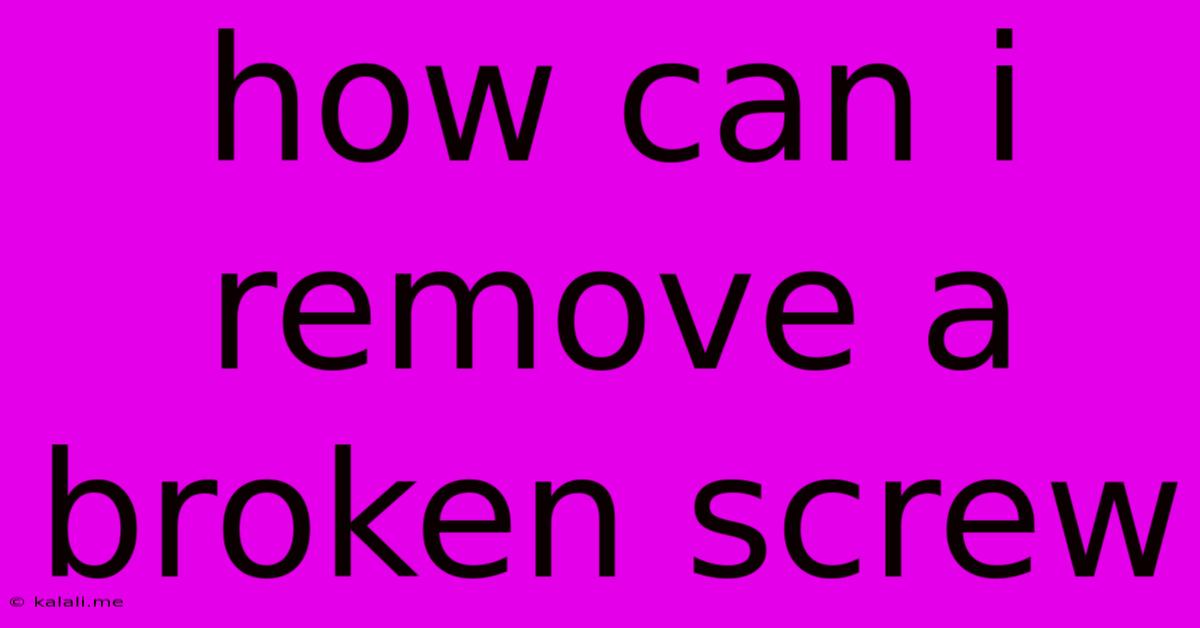How Can I Remove A Broken Screw
Kalali
May 19, 2025 · 3 min read

Table of Contents
How to Remove a Broken Screw: A Comprehensive Guide
Removing a broken screw can be incredibly frustrating, but with the right techniques and tools, it's entirely achievable. This comprehensive guide covers various methods, from simple solutions to more advanced techniques, ensuring you can tackle this common DIY problem. This article will cover everything from identifying the type of screw to the best tools for the job, helping you get your project back on track.
Understanding the Problem: The difficulty in removing a broken screw depends on several factors, including the type of screw (Phillips, slotted, Torx, etc.), the material it's made of, how deeply it's embedded, and the condition of the surrounding material. A stripped screw head is the most common culprit, making it impossible to get a grip with a regular screwdriver.
Assessing the Situation: Before You Begin
Before you start, carefully assess the situation. Consider:
- Type of screw: Identifying the screw type is crucial. Different screws require different approaches.
- Material: Is the screw made of soft metal (like brass) or a harder material (like steel)? This impacts the tools and techniques you should use.
- Embedding depth: How much of the screw is visible? A completely submerged screw requires more advanced methods.
- Surrounding material: Is the material the screw is in brittle (like some plastics) or strong (like metal)? This determines the amount of force you can apply without causing further damage.
Methods for Removing Broken Screws
Here are several methods to remove a broken screw, progressing from the simplest to the most complex:
1. Using a Screw Extractor: This is often the most effective method for stripped screws. Screw extractors are specialized tools with reverse-threaded bits that grip the broken screw and unscrew it. Choose an extractor slightly smaller than the screw's diameter. Drill carefully to avoid damaging the surrounding material.
2. Applying Heat: Heat can sometimes help loosen the screw. Use a heat gun or soldering iron to gently heat the area around the screw. The heat expands the metal, potentially loosening the grip and making it easier to remove. Caution: Be mindful of the surrounding material as excessive heat can cause damage.
3. Using a Vice Grip Pliers: If a small portion of the screw head remains, vice grips can offer a strong grip. Position the vice grips carefully to avoid slipping and damaging the surrounding material. Slowly apply pressure and attempt to turn the screw.
4. Drilling Out the Screw: As a last resort, you can drill out the screw. This requires precision and the right drill bit size. Drill slowly and carefully, ensuring the drill bit remains centered. You may need to use different sized drill bits to gradually remove the screw.
5. Using Super Glue and a Screw: For very small screws, you can apply super glue to the broken screw head and then carefully attach a small screw to it, allowing the glue to dry. Once dried, the new screw can act as a grip point for a screwdriver.
6. Specialized Tools: There are specialized tools designed for removing broken screws, including specialized driver bits with aggressive gripping teeth and easy-out screw extractors.
Preventing Broken Screws in the Future
Prevention is always better than cure. Here's how to minimize the chances of encountering broken screws:
- Use the correct screwdriver: Always use a screwdriver that perfectly matches the screw type and size.
- Apply even pressure: Avoid forcing the screwdriver. Apply even, consistent pressure when tightening or loosening screws.
- Lubricate the screws: Applying a lubricant like WD-40 can reduce friction and make screws easier to remove.
- Use the right torque: Don't over-tighten screws.
Removing a broken screw can be challenging, but by carefully assessing the situation and choosing the appropriate method, you can successfully remove the screw and avoid further damage. Remember to prioritize safety and work slowly and carefully to achieve the best results.
Latest Posts
Latest Posts
-
Can I Use Self Raising Flour For Cheese Sauce
May 19, 2025
-
Do You Need Xbox Live To Play Minecraft
May 19, 2025
-
Cannot Execute Binary File Exec Format Error
May 19, 2025
-
Bank 1 And Bank 2 Sensor
May 19, 2025
-
How Much Does A Garlic Clove Weigh
May 19, 2025
Related Post
Thank you for visiting our website which covers about How Can I Remove A Broken Screw . We hope the information provided has been useful to you. Feel free to contact us if you have any questions or need further assistance. See you next time and don't miss to bookmark.